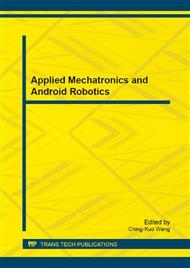p.196
p.200
p.205
p.209
p.213
p.219
p.225
p.229
p.234
A Study on the Introducing Plan and Process of TPM into Taiwan Traditional Industry
Abstract:
As needed by Taiwan industry upgrade, international competitiveness became a mutual goal for domestic traditional industries. Therefore, TPM equipment management strategy drew much attention from domestic industry. However, the current TPM promoters are mainly large scale industry since the introduction will put a huge amount of manpower and resources. Hence the study aimed to explore how to modify or reconstruct the proper models and procedures of TPM introduction to meet the needs of traditional industries. With this model, it is hoped that it could be used as a reference for proprietors in the process of implementing TPM, thus to reduce their exploration costs. It is also hoped that the study gains can be smoothly implemented in TPM activities in Taiwan traditional industries, thus enhance domestic competitiveness of traditional industries.
Info:
Periodical:
Pages:
213-216
Citation:
Online since:
September 2013
Authors:
Keywords:
Price:
Сopyright:
© 2013 Trans Tech Publications Ltd. All Rights Reserved
Share:
Citation:


